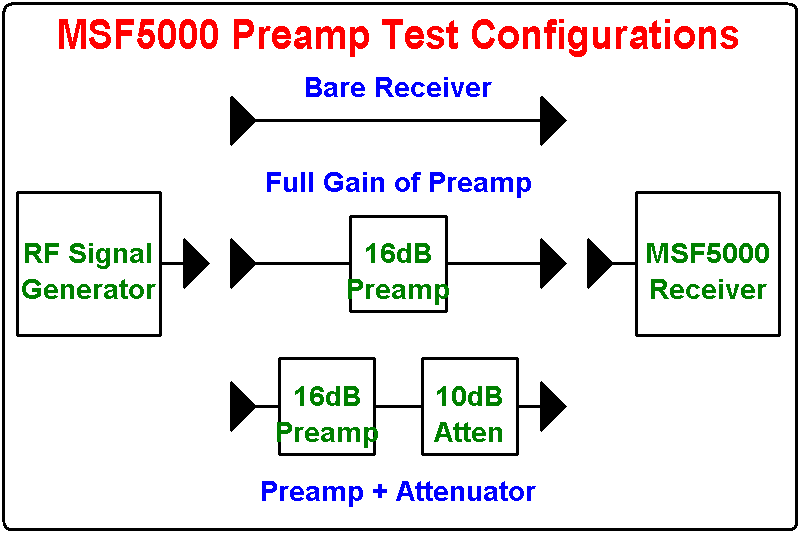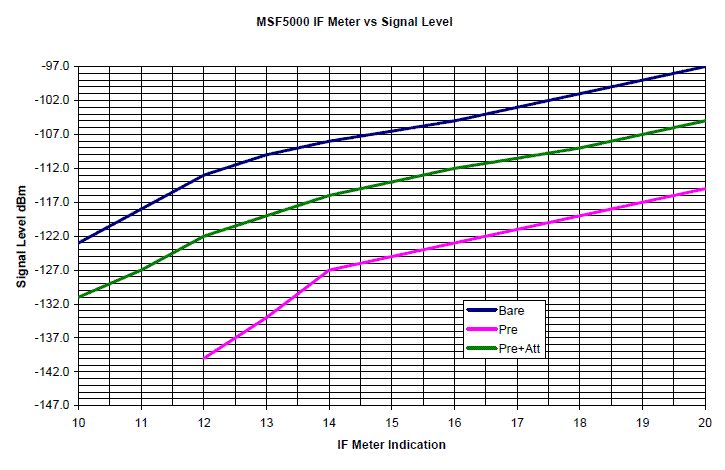Moto index
Back to Home
to an MSF5000
By Robert W. Meister WA1MIK

|
MSF index Moto index Back to Home |
Adding a Preamp to an MSF5000 By Robert W. Meister WA1MIK |

|
This article is mainly concerned with UHF (430-470 MHz) stations, however the techniques and outcome probably apply to all the other bands as well as other makes and models of receivers.
The RF section of a typical repeater consists of an antenna, 50 or more feet of coaxial cable, a duplexer, two short (2-3 feet) coaxial cables going to the station, and the repeater itself. The antenna usually has some gain. Every length of coaxial cable, every connector and adapter, and the duplexer has some loss. Ideally, a preamp would overcome the losses and amplify the incoming signal without increasing the noise level.
Test Setup:
I used a 75w MSF5000 configured for full duplex (separate antenna jacks) tuned to 449.450 MHz. A diagnostic metering panel was connected to the station to monitor its operation and provide receiver metering. The receiver was placed in carrier squelch mode by raising the "PL DIS" switch on the controller. The transmitter was disabled by raising the "ACC DIS" switch on the controller. I used a Fluke 6071A RF signal generator as the signal source. It fed the station through a three foot length of RG400 double-shielded coaxial cable terminated with BNC connectors. N-male to BNC-female adapters were used at each end of this cable to mate with the station and an ARR GaAsFET preamp, which are equipped with N-female connectors. One N-male to N-male adapter was used at the output of the preamp. The coaxial attenuator has an N-male connector at one end and an N-female connector at the other.
The Bare Receiver:
Let's play with some typical numbers using dBm, where zero (0) dBm is 1 millivolt across 50 ohms. Start with a 0.3 microvolt signal at the antenna (-117 dBm). To keep things simple, we'll use a simple 1/4 wavelength ground plane with a gain of 0 dB, so the signal level leaving the antenna is -117 dBm. 100 feet of 1/2 inch diameter coaxial cable typically has 2 dB of loss at 400 MHz, so the signal arriving at the duplexer is now -119 dBm. The duplexer and its short cables and connectors will typically add another 2 dB of insertion loss, so our signal level is -121 dBm at the receiver input. We've lost 4 dB of signal level in this example. It will be more if your coaxial cable run is longer; it will be less if you use larger diameter cable. A UHF MSF5000 has a 20 dB quieting sensitivity of about 0.4 microvolts (-115 dBm), so our original 0.3 microvolt signal is now down to -121 dBm, barely enough to open the squelch, and certainly quite noisy. The receiver's IF LEVEL meter (M2) shows 10.5 uA.
Adding 16 dB Gain:
So you figure you can improve things by adding a preamp. Check the specs; most stand-alone preamps have about 16 dB of gain or more. They amplify the signal you want as well as the noise you don't want, and they add a bit of noise in the process. So with that 16 dB gain preamp, that -121 dBm signal at the receiver would be amplified to -105 dBm, a big improvement, at least on paper. The receiver's IF LEVEL meter (M2) shows 17 uA.
Now, let's also assume that the noise level at the antenna is 0.1 microvolt (-127 dBm). The receiver doesn't even see this. With the antenna, coax, and duplexer gain and losses, the noise level at the receiver would be -131 dBm. Add the 16 dB gain from the preamp and now the noise has grown to -115 dBm or maybe even a bit more, due to preamp-generated noise. With no other signal present, the receiver's IF LEVEL meter (M2) shows 12 uA on just noise. It does drop down to 10 uA when I disconnect the signal generator. Even with double-shielded coax, the signal still gets in.
Adding 6 dB Gain:
What you need to do is provide enough amplification for the signal you want, while keeping the noise level below the threshold of the receiver. As it turns out, you really only need enough gain to compensate for the losses provided by the coax cables and duplexer, or about 4 dB in this case. Add a couple of dB for some actual gain, and now that 16 dB gain preamp has about 10 dB too much gain. The way around this is to add 10 dB of attenuation to the preamp's output. This reduces the actual gain to about 6 dB, which is all the receiver really can deal with. So, back to our 0.3 microvolt signal that enters the receiver at -121 dBm. Add just 6 dB of gain and you've got -115 dBm, which puts it well over 20dB quieting and the IF LEVEL meter (M2) shows 14 uA.
Summary:
The diagram below illustrates the three test configurations.

The following table lists the signal levels (in dBm) required for specific IF LEVEL meter readings for the configurations above: the bare station with no preamp, the station with the 16 dB ARR preamp, and the station with the 16 dB ARR preamp and a 10 dB coaxial attenuator between the preamp and the station. The cells with red background are the 20 dB quieting points.
|
 |
Important points to note:
As it turns out, the 16 dB gain I used throughout the article was found in an older ARR preamp data sheet. The current information on their web site says the UHF preamps have 18 dB of gain, and this is shown in the results above.
Conclusions:
Look at the signal levels needed for 20 dB quieting. There's a 6-8 dB difference (the gain of the preamp minus the loss of the attenuator) between the first and third tests. By removing the 10dB attenuator, you only gain 2 dB more useful sensitivity but notice how the IF LEVEL meter value is much higher with all that un-needed gain. That's all noise, even though it doesn't seem like it on the bench. When you hook everything up at the repeater site, the receiver will be overwhelmed with all that extra gain and you won't get the improvement you saw on the bench.
You could place the 10dB attenuator at the preamp's input, but then you'd be reducing the desired signal to the point that the preamp-generated noise would be a significant part of the signal seen by the receiver. ARR also recommends adding attenuation after the preamplifier. Amplify everything first, then reduce the output level feeding the receiver.
You want just enough gain so the receiver's IF LEVEL meter indication does not increase when you connect the rest of the antenna system. This means the noise level is not being amplified so much that it hides the signal you want to receive.
It's interesting to note that the preamp designed for the MICOR mobile radio back in the 1970s provided only 6 dB of gain. Motorola must have known something back then: that too much gain was detrimental to the operation of the receiver.
Contact Information:
The author can be contacted at: his-callsign [ at ] comcast [ dot ] net.
Up one level (MSF index)
Up two levels (Moto index)
Back to Home
This article was started in May 2014.
This page was created August 20 2014.
This web page, this web site, the information presented in and on its pages and in these modifications and conversions is © Copyrighted 1995 and (date of last update) by Kevin Custer W3KKC and multiple originating authors. All Rights Reserved, including that of paper and web publication elsewhere.